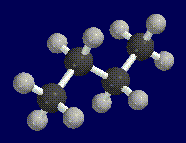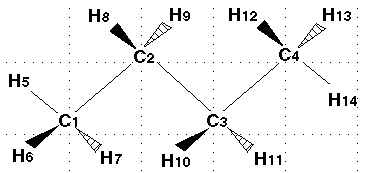|
Home
Z-Matrices
Z-Matrix Main Page
Students
Introduction
Objectives
Background Reading
Procedure
Questions
Further Work
References/Support Materials
Teachers
Additional Background
Materials
Standards
First year chemistry curriculum concepts
Second year chemistry curriculum concepts
Cartesian Converter Materials
Z-matrix to Cartesian Converter
Cartesian Converter Example
Help Instructions for the Z-matrix to Cartesian Converter
Readings
Overview
Atomic Orbitals
Lab Activities
Z-matrices
Basis Sets
Geometry Optimizations
Ionization Energies
Support Materials
Interactive Tools
Glossary of Terms
Related Links
ChemViz
Computational Chemistry
SUCCEED's Computational Chemistry
Developers' Tools
What's New?
Discussion Board
Team Members
Email the Group
Contact Webmaster
|
 |
This is Butane. |
Steps:
| Here is the numbered molecule. Use this as a reference when following
along in the example. Notice that the black arrow means that the atom is
coming out of the screen and towards you. The shaded arrows mean that the atom
is going into the monitor. |
 |
- First we must decide which atom will be atom C1. We'll pick the carbon to
the left and call it C1. Place this at the origin.
- Next we must order the rest of the atoms. Designate the other carbons C2,
C3 and C4. The rest of the hydrogens will be H5 through H14.
- Now we must look at the C2 atom. Using our reference charts, we find the
single bond length between two carbons equals, 1.54 angstroms.
- Next look at atom C3. Its bond length to atom C2 equals 1.54 angstroms.
The bond angle formed between the first three atoms equals 110.0 degrees.
| C1 |
|
|
|
|
|
|
| C2 |
1 |
1.54 |
|
|
|
|
| C3 |
2 |
1.54 |
1 |
110.0 |
|
|
- Next we look at atom C4. As before, its bond length with atom C3 equals
1.54 angstroms. Its bond angle with atoms C2 and C3 equals 110.0 degrees. Its
dihedral angle with atoms C1,C2,C3 equals 120.0 degrees.
| C1 |
|
|
|
|
|
|
| C2 |
1 |
1.54 |
|
|
|
|
| C3 |
2 |
1.54 |
1 |
110.0 |
|
|
| C4 |
3 |
1.54 |
2 |
110.0 |
1 |
120.0 |
- Atom H5 is the first hydrogen atom we will look at. We can see that it
forms a 1.09 angstrom bond length with atom C1. It also forms a 110.0 bond
angle with atoms C1 and C2 and a 120.0 degree dihedral angle with atoms C1,C2,
and C3. Thus, the z-matrix now looks like this:
| C1 |
|
|
|
|
|
|
| C2 |
1 |
1.54 |
|
|
|
|
| C3 |
2 |
1.54 |
1 |
110.0 |
|
|
| C4 |
3 |
1.54 |
2 |
110.0 |
1 |
120.0 |
| H5 |
1 |
1.09 |
2 |
110.0 |
3 |
120.0 |
- All of the hydrogens will have the same measurements, but will reference
different atoms. Remember to only use previously defined atoms when
identifying your current atom. Your final z-matrix should look like this:
| C1 |
|
|
|
|
|
|
| C2 |
1 |
1.54 |
|
|
|
|
| C3 |
2 |
1.54 |
1 |
110.0 |
|
|
| C4 |
3 |
1.54 |
2 |
110.0 |
1 |
120.0 |
| H5 |
1 |
1.09 |
2 |
110.0 |
3 |
120.0 |
| H6 |
1 |
1.09 |
2 |
110.0 |
3 |
120.0 |
| H7 |
1 |
1.09 |
2 |
110.0 |
3 |
120.0 |
| H8 |
2 |
1.09 |
3 |
110.0 |
4 |
120.0 |
| H9 |
2 |
1.09 |
3 |
110.0 |
4 |
120.0 |
| H10 |
3 |
1.09 |
2 |
110.0 |
1 |
120.0 |
| H11 |
3 |
1.09 |
2 |
110.0 |
1 |
120.0 |
| H12 |
4 |
1.09 |
3 |
110.0 |
2 |
120.0 |
| H13 |
4 |
1.09 |
3 |
110.0 |
2 |
120.0 |
| H14 |
4 |
1.09 |
3 |
110.0 |
2 |
120.0 |
|

